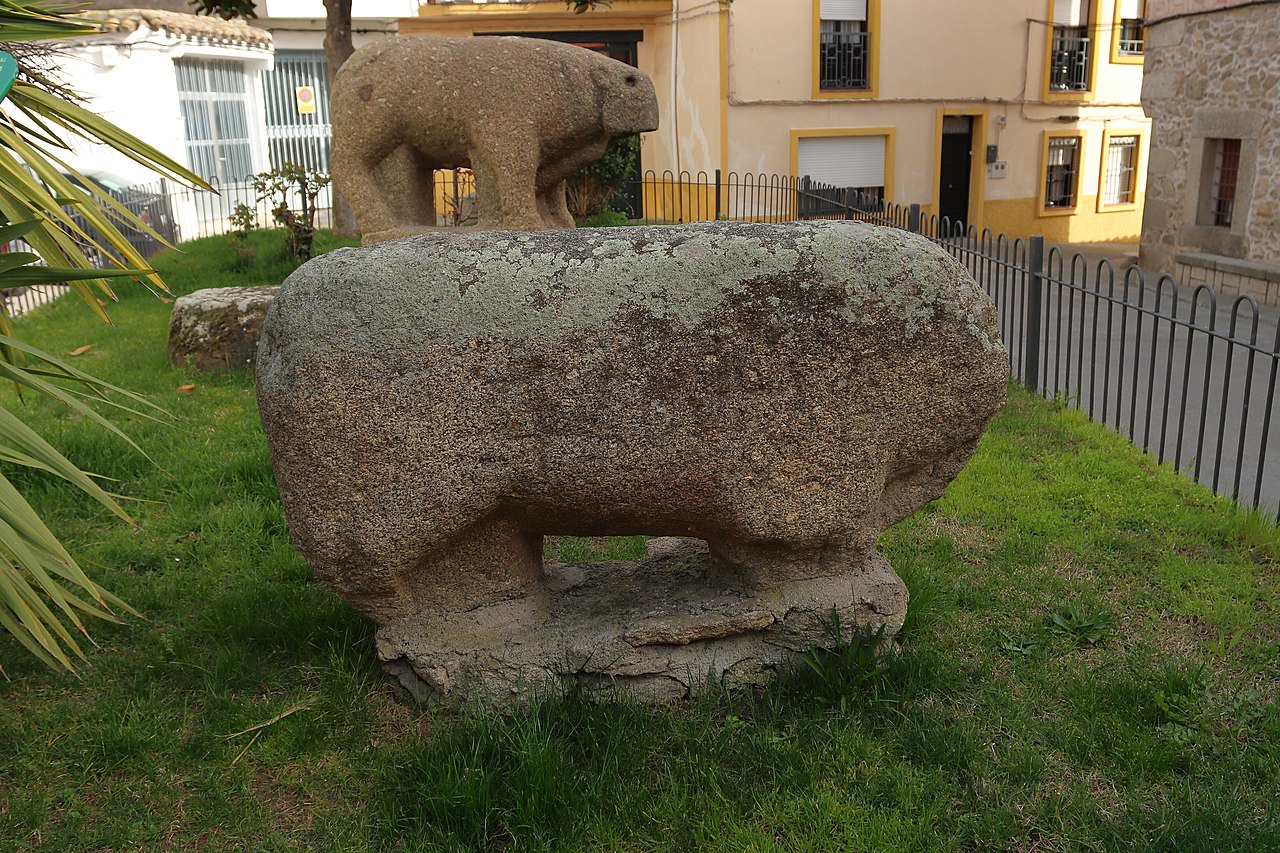Castillo de Bayuela

Torre De Bayuela

Verraco vetón
Information about Castillo de Bayuela:
 Telephone: 925 862 001
Telephone: 925 862 001
 Web: https://www.sierradesanvicente.com/castillo-de-bayuela/
Web: https://www.sierradesanvicente.com/castillo-de-bayuela/
 Info:
Info:
 Email: castillodebayuela@diputoledo.es
Email: castillodebayuela@diputoledo.es
This municipality has been inhabited since ancient times, as is attested by the numerous archaeological remains found from the Palaeolithic and Neolithic periods, settlements that culminated in the construction of a Vetton castro on the Castle Hill where the famous boars were found, which are currently located in the town's Plaza de San Antonio.
Subsequently, Romans, Visigoths and Muslims inhabited its lands, which is why the cultural heritage of the town and its municipal area is quite significant, with the ruins of the Medieval castle, first Muslim and then Christian, standing out. It was around this castle and its beautiful natural landscapes that this town first arose and then moved further down into the valley where the present location of the municipality is found. In the 14th century, it became an independent town, where the jurisdictional roll was erected to administer justice. Culture and Nature merge in a unique environment where visitors can enjoy hiking and learn about its rich cultural and natural heritage through the Nature Interpretation Centre located in this town.
Tourist Information
Find out more
What to see?
Erected around 1480 and in continuous evolution, it is mainly Gothic-Renaissance in style. It is a church with a single nave and a semicircular chevet covered with a ribbed vault in terceletes. After Juan de Azpeitia's intervention in the mid-16th century, the work was handed over to Pedro de Tolosa (the quantity surveyor of El Escorial) who carried out the main doorway between 1560 and 1564. In 1924 the interior and all its treasures were destroyed in a dreadful fire, and after its restoration, in 1934 the Ruiz de Luna firm erected the great altarpiece recognised as the "Sistine Chapel" of the Ruiz de Luna family.
Located in the town hall square, it is in the late Gothic style of the early 16th century. Referred to as "the king of the rolls" in the province of Toledo, it is an architectural work of great beauty and slenderness. It stands on a circular grandstand, a large monolithic column supports a capital with four tawny heads under a pavilion. Two identical coats of arms of the Mendoza family appear as the promoters of this building.
Its ruins are located to the northwest of the town. These are the remains of an ancient wall of Vetton origin and rebuilt in medieval times with several accesses and some towers. Located in the centre is the old Mudejar church from the 13th century ,Sª Mª del Castillo, built on a Muslim watchtower and later enlarged A highlight is its bell tower built in brick and stone. A large horseshoe arch can be seen here. On the adjoining esplanade, there are still some remains of Bronze Age cave paintings, the foundations of old medieval houses and an ancient cistern.
Sculptures in the shape of animals known as 'El Toro', the 'Verraco' and the 'Guarra', which the Vetonean culture left as a legacy more than two thousand years ago. It is speculated that they are symbols marking livestock routes, also used as religious elements or as funerary monuments. They were taken down from the Vetón castro of El Castillo and are located in the Plaza de San Antonio in this town.
This is a late Bronze Age stele. It is a perfectly preserved stone monolith with a schematic drawing of a warrior on its main face. This is one of the largest and best-preserved warrior stelae on the peninsula, as well as having the largest warrior drawing. It is currently located in the Nature and Historical Heritage Interpretation Centre.
Ancient mills used to grind flour. It is a very common ethnographic element in the San Vicente mountain range. There are the remains of two bucket mills, dating from the 16th-18th centuries, on the Guadamora stream. In the nearby Saucedoso stream, six mills are preserved in an area known as 'Puente de los Molinos' (Bridge of the Mills), forming a landscape of great rural and natural beauty. The bridge of Los Molinos dates back to 1607, and is supported on two rocks over the stream that facilitates the way to the neighbouring village of Garciotum. It has a single eye in a semicircular arch.
Located next to the public school. Divided into two spaces, the first one of nature with explanatory panels about the richness of the flora and fauna of the region as well as two complete collections of rocks and bird feathers. The second area is dedicated to historical heritage with panels explaining the rich history and monuments and a large display of archaeological artefacts from the Palaeolithic to the Middle Ages. The Guerrero Stela, the largest archaeological piece of its type on the peninsula, stands out above all else.
It is located in the so-called Parque de los Austrias, to the north of the city centre. Sculpted in granite, it is also known as the 'Fuente de los Austrias', because in 1938 a fountain was created using the coat of arms itself. It was built in 1603, but the reason for this is unknown.
It was located in the Plaza de San Antonio and dates back to the 17th century. Only its doorway remains as the last vestige of this building where grain was stored and which dates back to 1534. It is a lintelled doorway built in stone and with characteristics common to other doorways from the same period.
